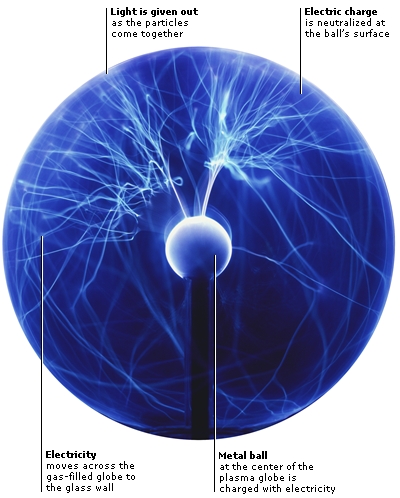DK Science: Electricity
Electricity is not just something you buy in a battery. It is one of the basic ingredients of the Universe. Everything around us is made of invisible atoms, and the atoms contain particles that carry electric charge. Charge can be positive or negative. Particles with the same kind of charge repel each other, while opposite charges attract. When charges move, we get CURRENT ELECTRICITY, which drives much of the modern world.
Electricity is a basic force of nature, and lightning shows how powerful it is. Lightning happens when strong air currents tear apart positive and negative electrical charges. This creates huge tension, eventually released as a giant spark caused by STATIC ELECTRICITY. Electricity can destroy and kill, but engineers can tame its wild power to light whole cities.
Everything in the Universe is made of atoms, and atoms are held together by electricity. In an atom, negatively charged electrons swarm around a positively charged nucleus. A positive charge attracts a negative charge, so electrons rarely escape the pull of the nucleus. As the charges cancel each other out, the atom as a whole has no electric charge.
We rarely notice the electricity all around us, because positive and negative charges usually balance. However, when objects touch, electrons can hop between them. This may leave each object with a static charge. A comb, for example, can strip electrons from hair, making the hair positively charged, crackly, and fly-away.

This plasma ball is an exciting demonstration of static electricity. The centre is charged to a very high voltage (electrical pressure), creating electrical stress in the low-pressure gas inside the ball. This tears the gas atoms apart to form particles that shift the charge to the outer wall. When the particles come together to form atoms again, they give out a bright light.
Charged objects are attracted to uncharged objects. This effect (electrostatic induction) is used in paint spraying. The object to be painted is connected to the ground so it stays uncharged. A spraygun charges the paint, and electrostatic induction pulls the paint onto the object so that every bit gets painted, even the back.
Static electricity depends on electrons not being able move around easily, so that charge builds up in one place. But in some materials – mostly metals – electrons can move freely to form an electric current. An electric current is measured by the amount of charge passing a fixed point each second. In most currents, the electrons move more slowly than a snail.
At a rock concert, huge quantities of electricity are controlled by tiny electric currents in microphones to produce deafening sound. Electricity is also used to make lights blaze, and cameras turn the light into electrical signals to create giant images of the musicians above the stage. The whole show is run by electronic computers.
When electrons jostle their way through a metal, such as copper, they make the metal hot. The metal may even melt. This could be a disaster, but not when the process is used for joining metal parts by welding. In welding, a rod connected to a low-voltage supply of electricity is touched on to the metal parts that need joining. A brilliant electric arc forms as the tip of the rod is vaporized (turned into gas), and the parts join. Arc welding even works under water, to build and repair pipelines and oil rigs.
